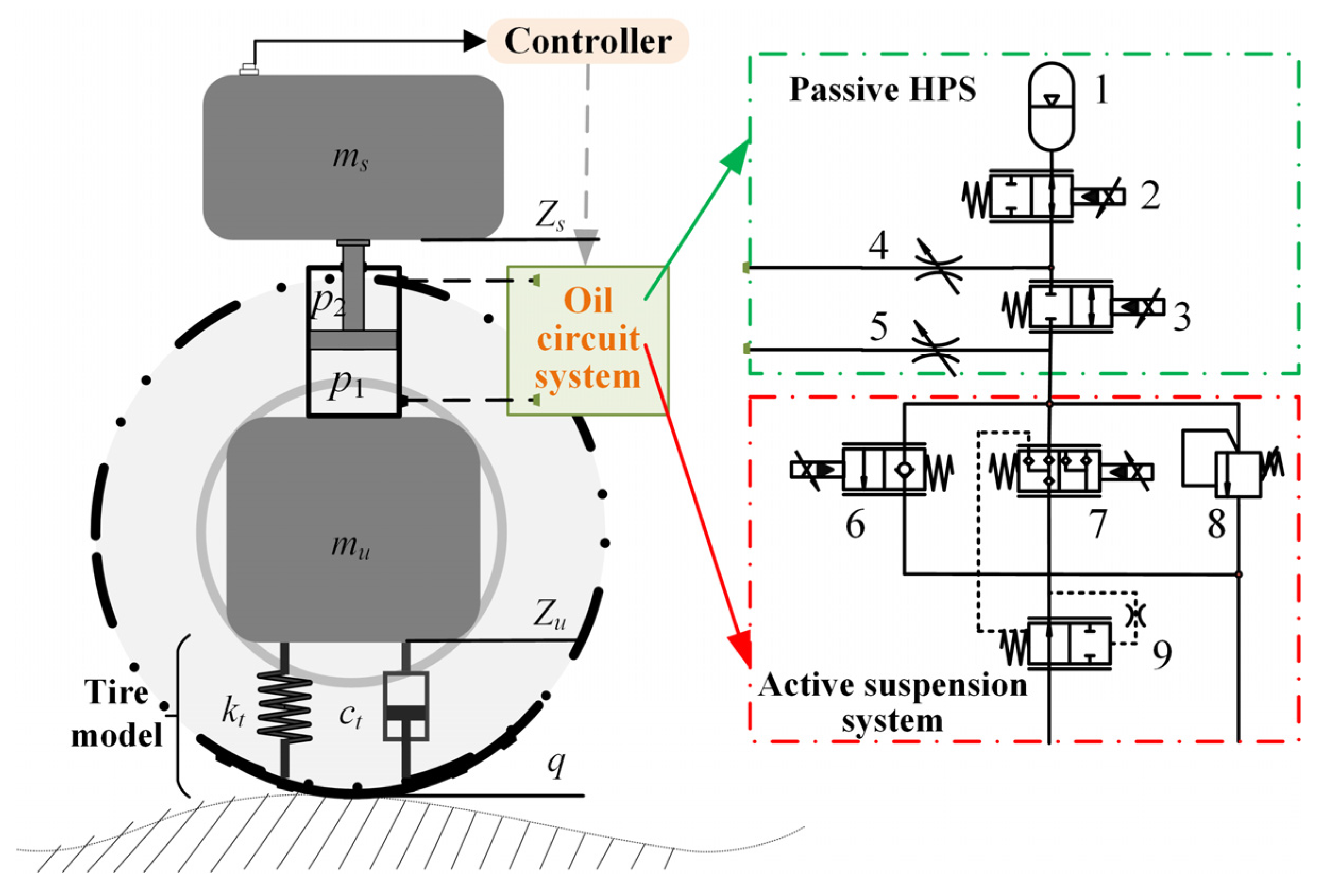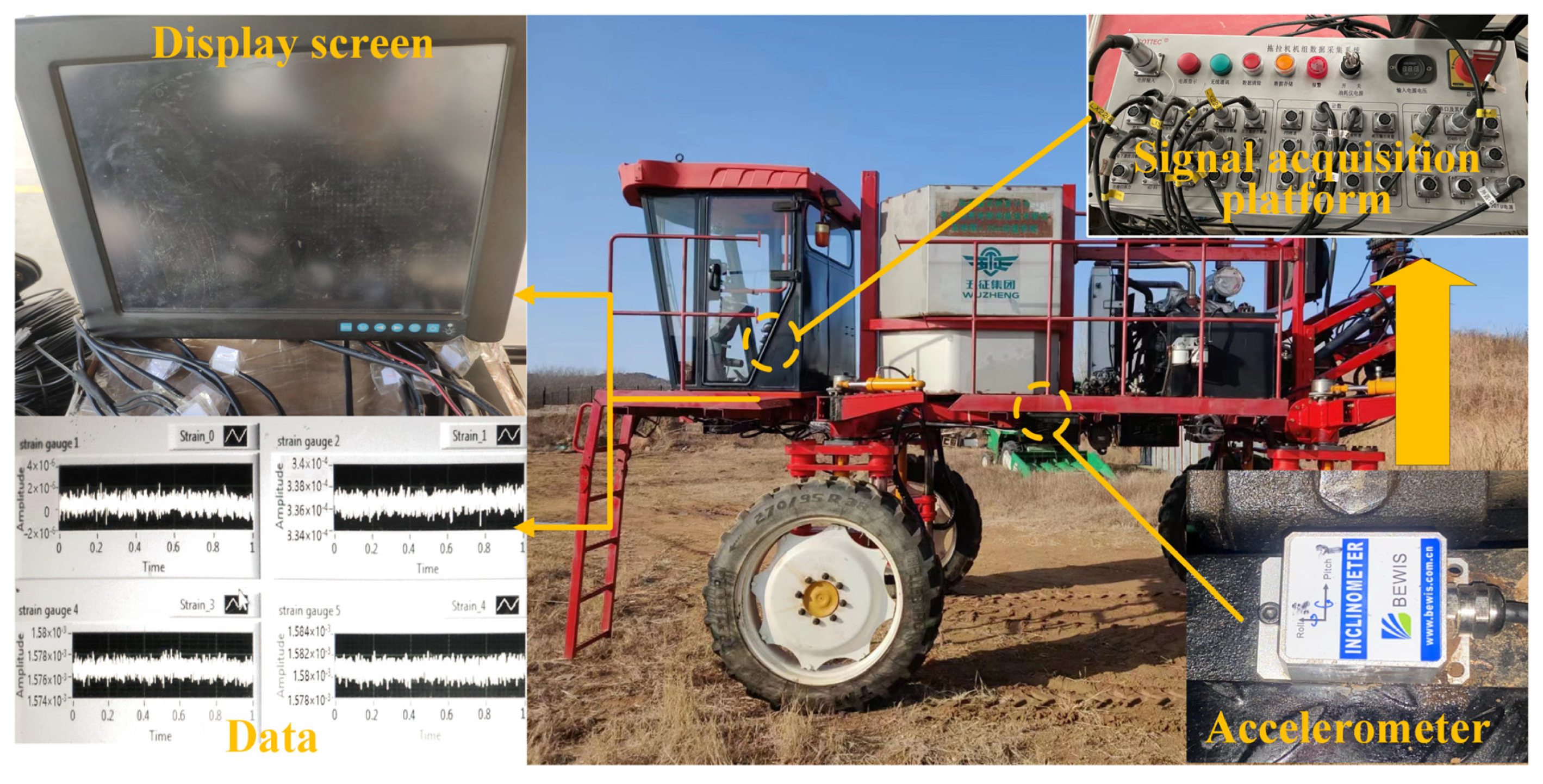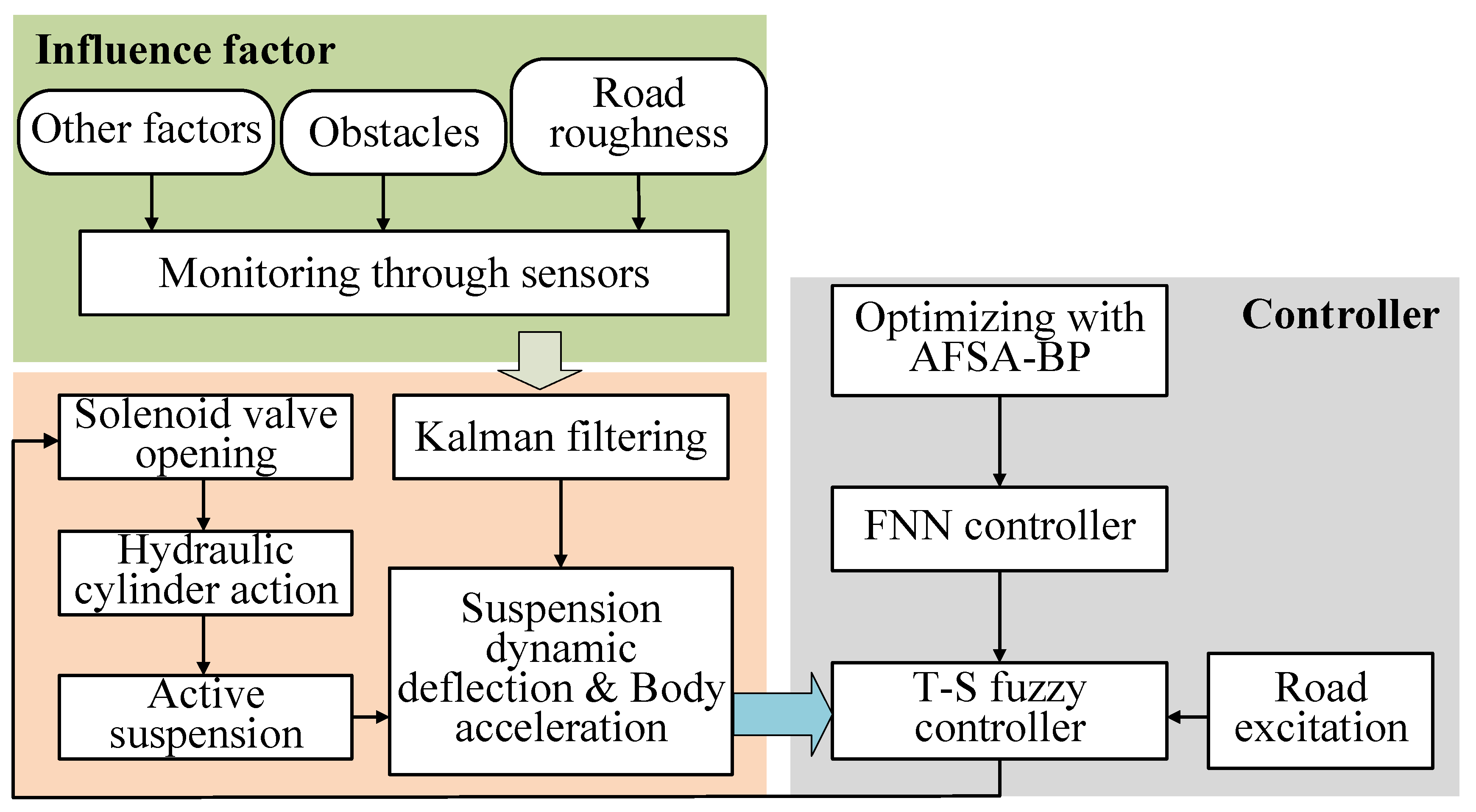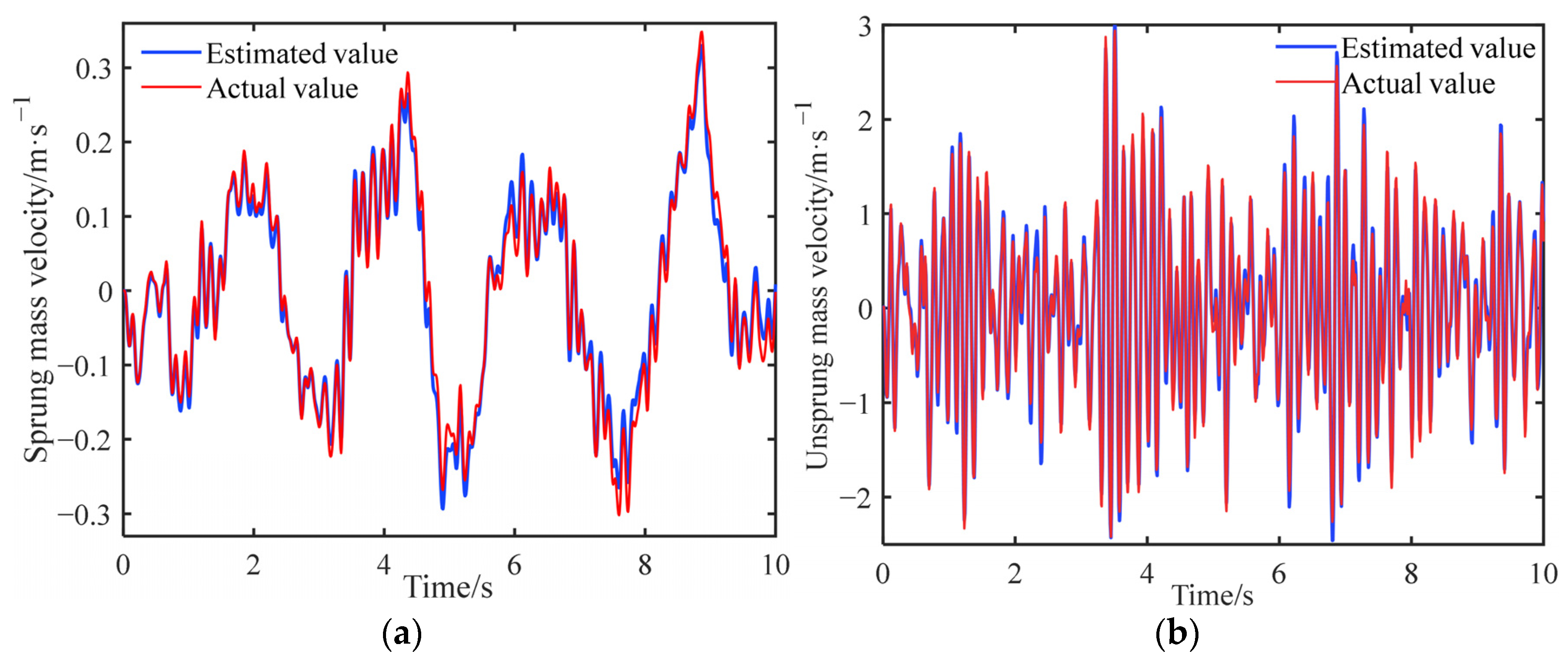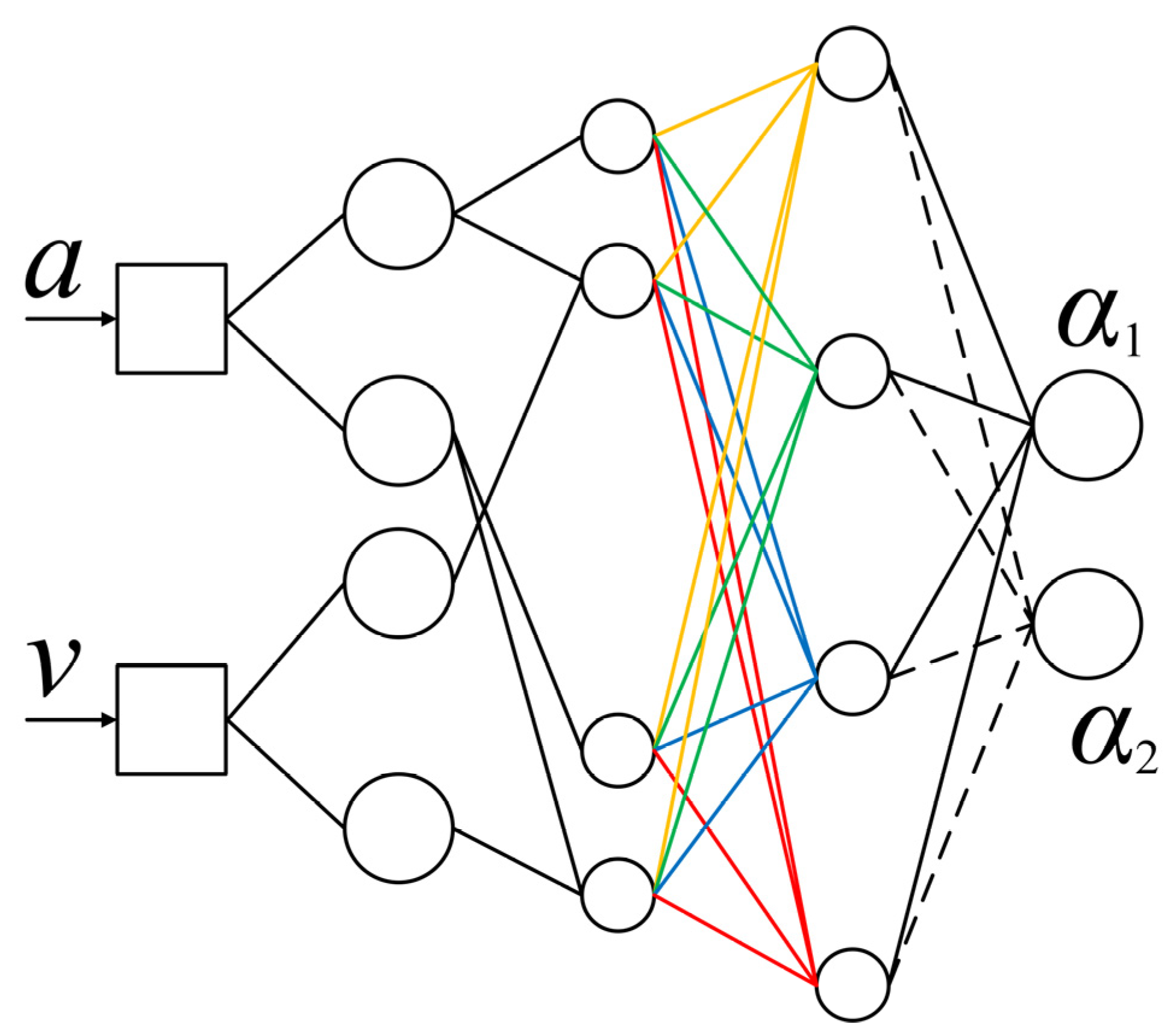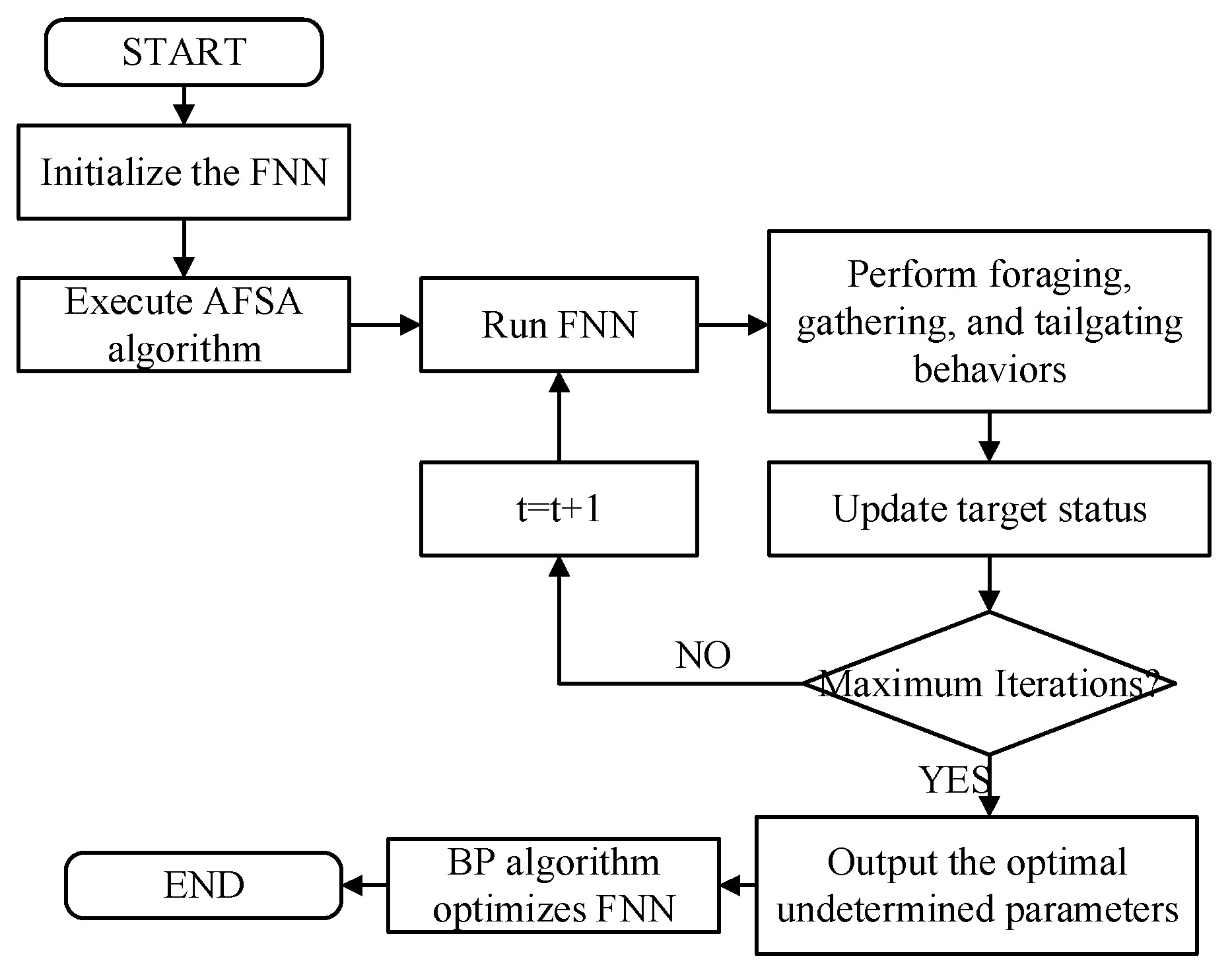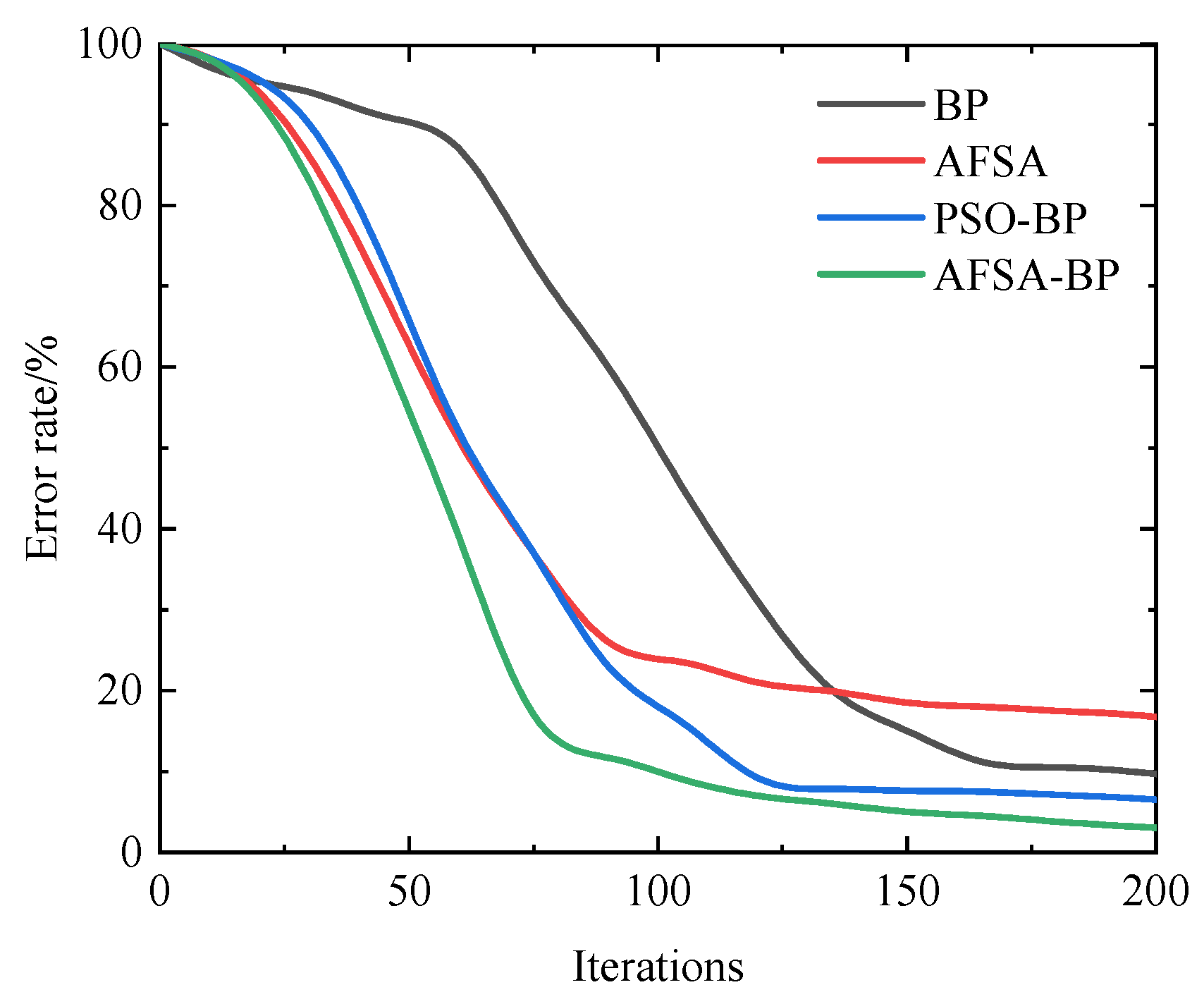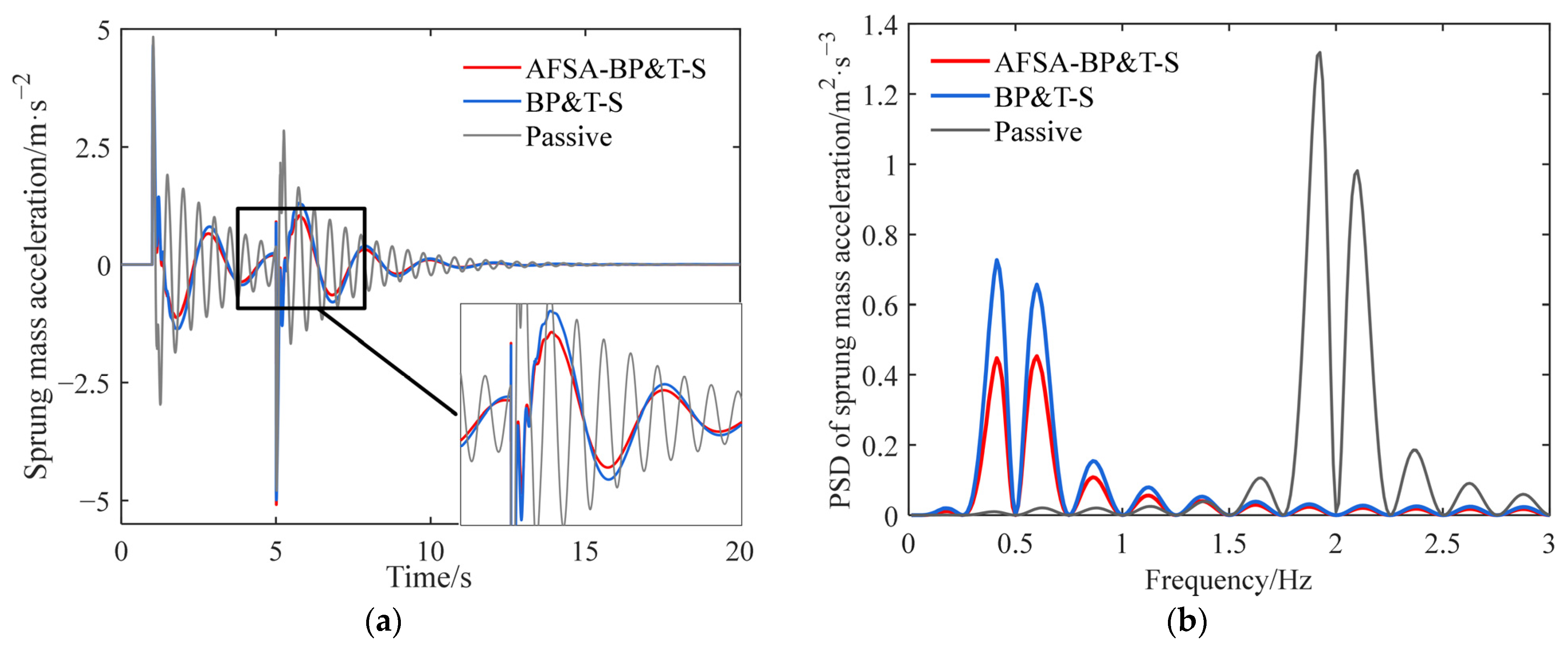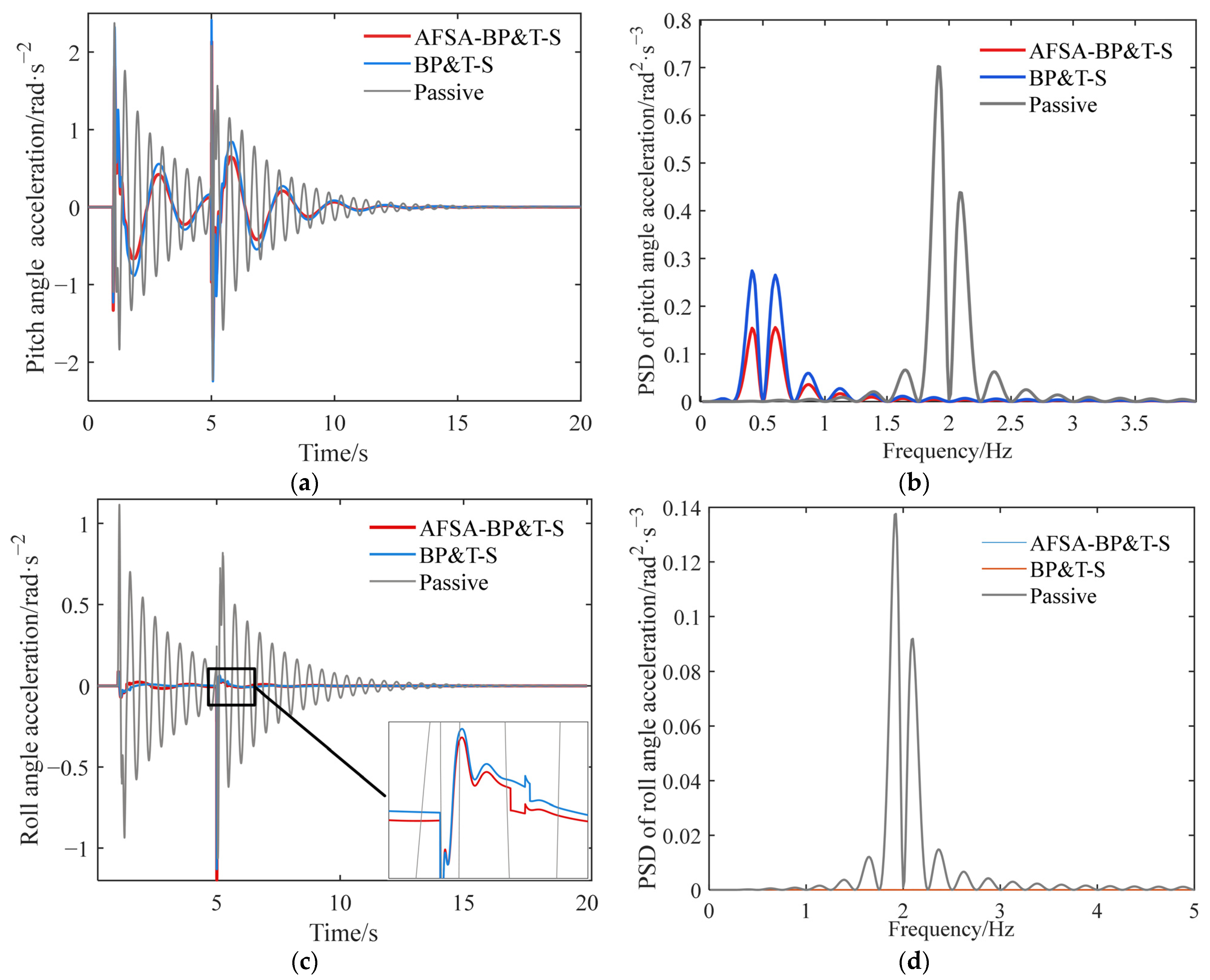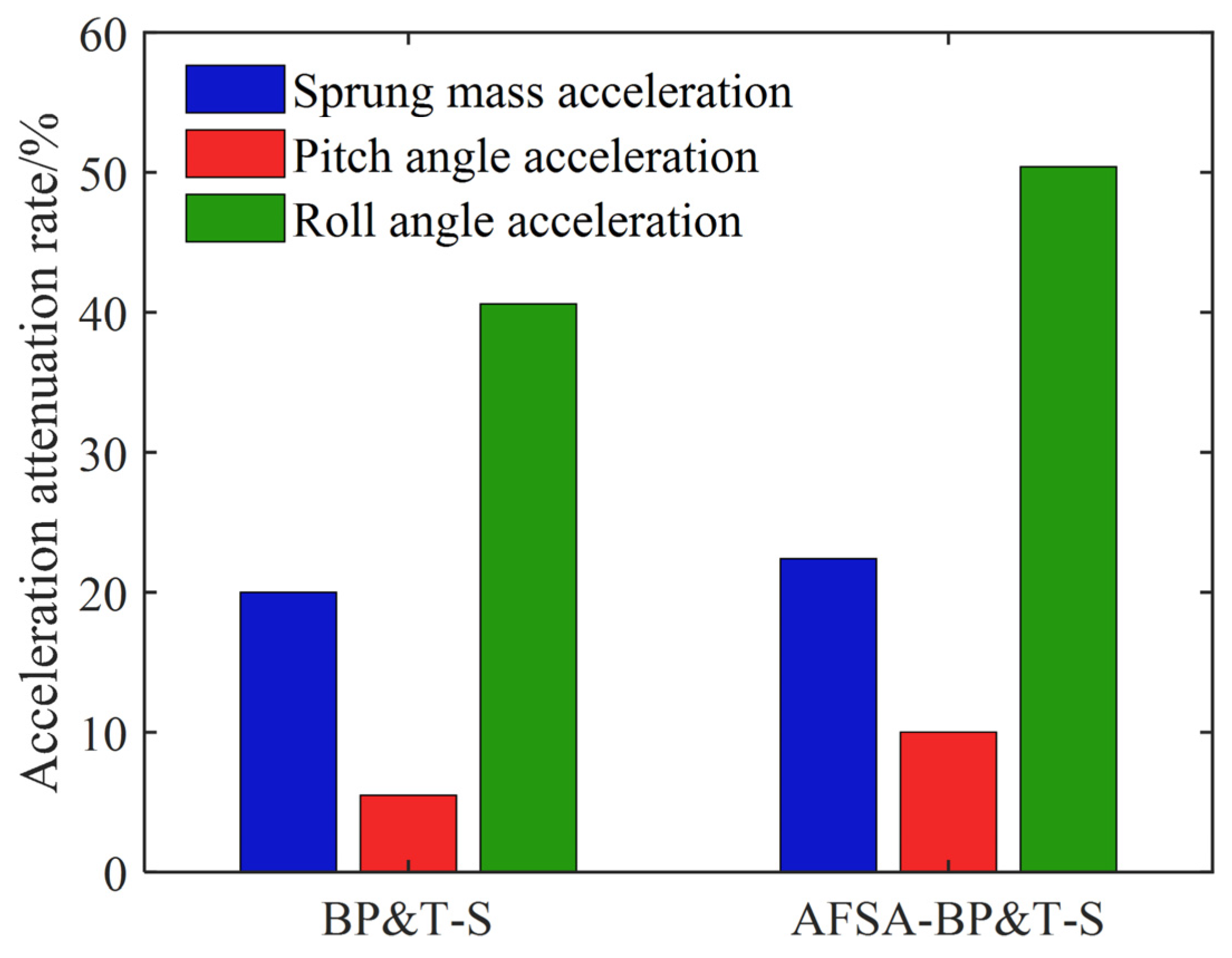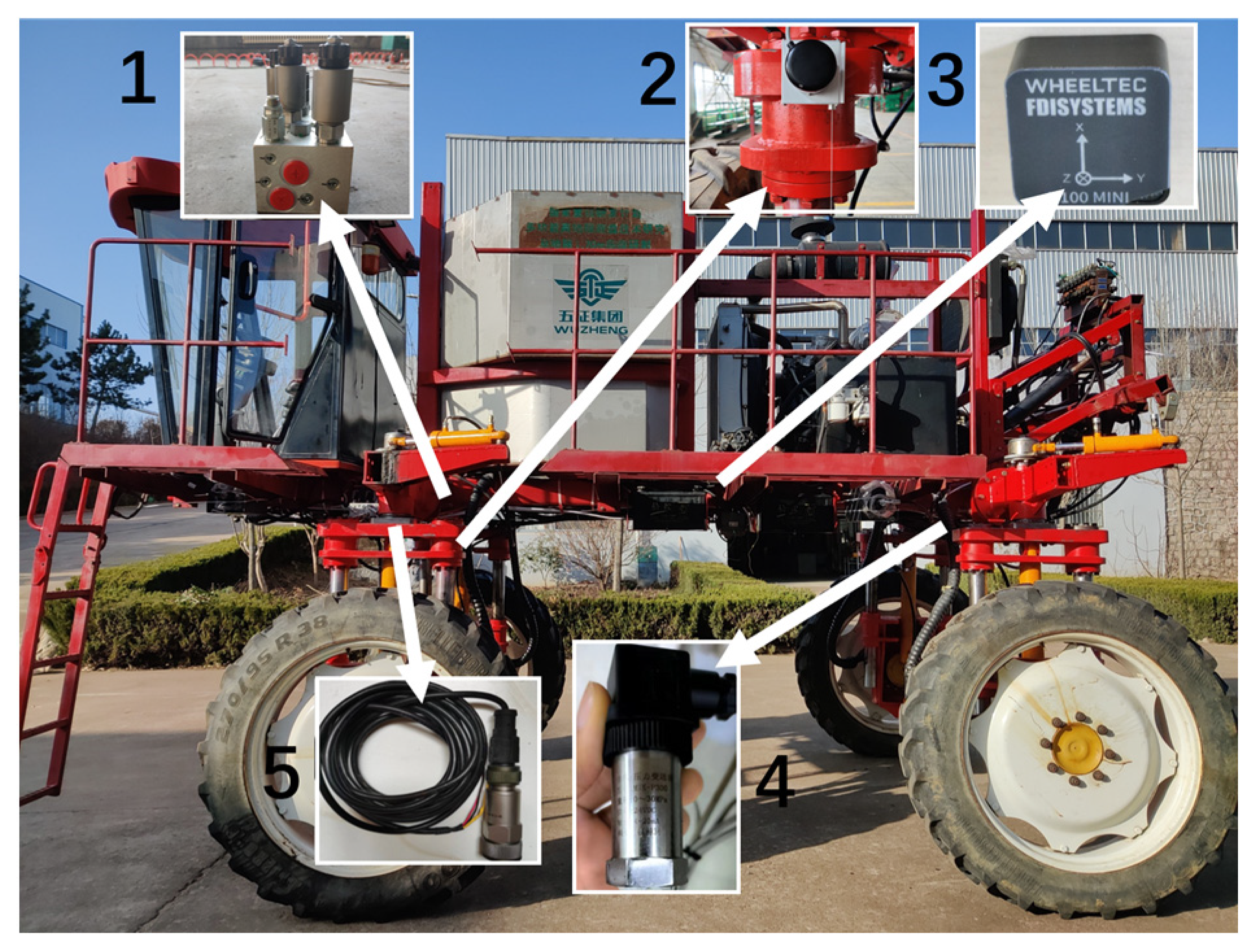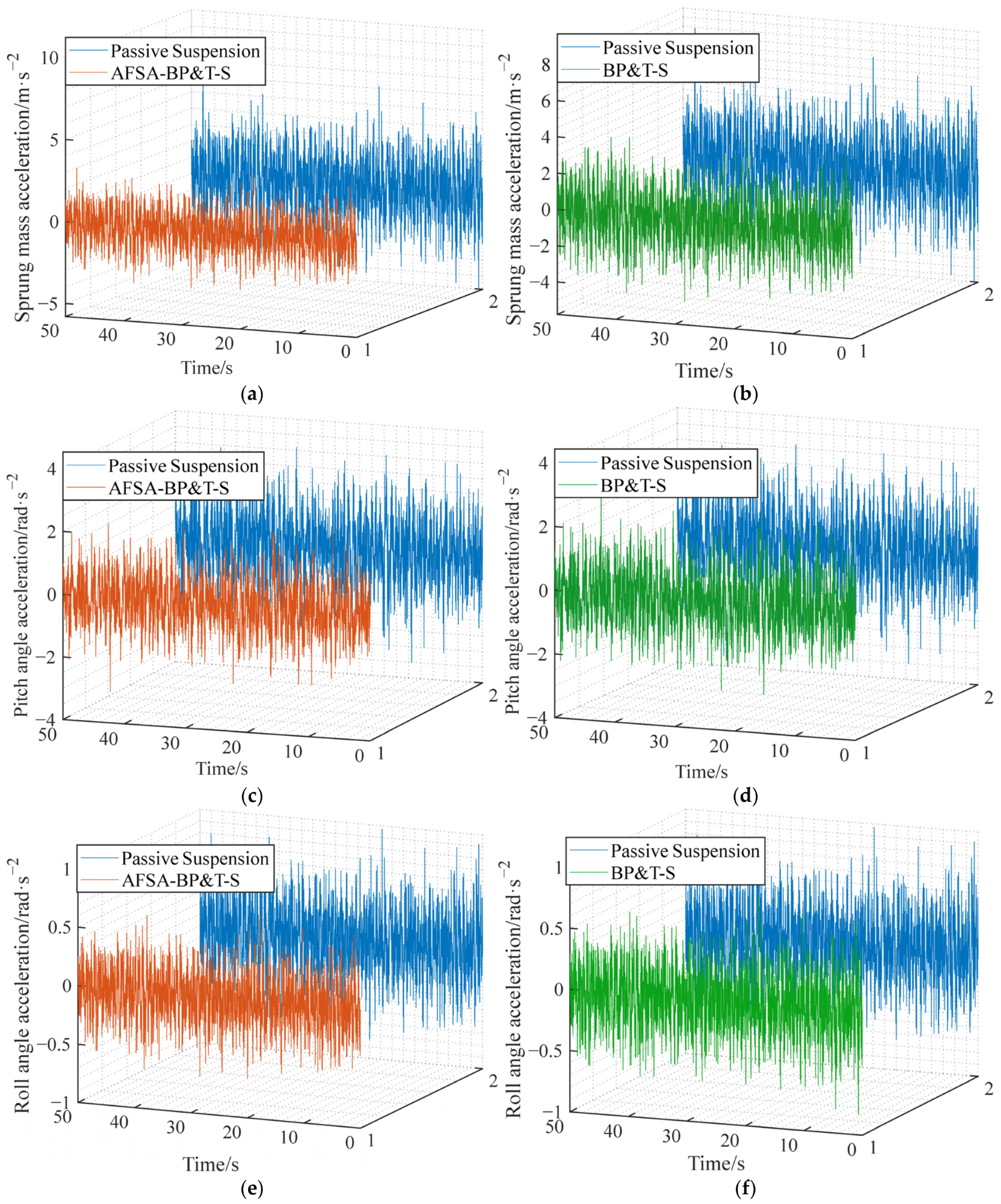2.2.1. State Observer
Due to spatial constraints and technological limitations under harsh working conditions, critical parameters such as sprung mass velocity during the operation of sprayers are often unattainable through sensor measurements. Moreover, the method of integrating and transforming signals received from acceleration sensors is prone to system drift and noise interference, resulting in significant errors in the converted data and subsequently affecting the accuracy of the observation state. To precisely monitor the suspension’s operating status and provide real-time running state input for active vibration reduction, a state observer based on Kalman filter is established based on the acceleration signal received by the body acceleration sensor. This approach enables the estimation and prediction of the suspension state.
Given the limitation of authenticating the state observer’s veracity through actual vehicle testing, it is imperative to establish a Simulink-based random road input model and integrate it into the suspension 1/4 dynamic model to validate the model’s effectiveness. The sprung mass velocity and unsprung mass velocity are used as control groups, and the estimated values of the Kalman filter are compared. The differential of the road input displacement [
27] is shown as follows:
where
vt is the vehicle speed, m/s;
n0 is the k, taken as 0.011 m
−1;
G(
n0) is the road surface roughness coefficient, m
2/m
−1;
w(
t) is the mean value, taken as 0.
Utilizing the Class D road as a case study, the sprung mass velocity and unsprung mass velocity of the sprayer are estimated based on the acceleration sensor signals gathered at the sprung mass location, as detailed in
Section 2.1.3. These estimates are then compared against the theoretical values derived from the road input model to ascertain the prediction outcomes of the state observer, as shown in
Figure 5.
Based on the simulation curve depicted in
Figure 5, it is evident that the suspension parameters derived through Kalman filtering exhibit a robust correlation with the actual state, manifesting a consistent fluctuation pattern and a substantial overlap between the respective curves. To further gauge the tracking proficiency of the observed values against the actual values, a tracking performance evaluation metric is introduced, as shown in the following equation [
30].
where
z is the true value of the observed signal;
z′ is the estimated value of the observed signal;
N is the data number.
After substituting the data into the calculations, the curve fitting degrees of the sprung mass acceleration and the unsprung mass acceleration are 79.22% and 81.62%, respectively. For the hydro-pneumatic suspension exhibiting strong nonlinear characteristics, the Kalman filter can effectively observe the motion state of the suspension system, and the estimated value is within the reasonable error range, which proves the effectiveness of the Kalman filter observer, addressing the issue of the system state being unmeasurable, and providing the basis for parameter input for the subsequent design of an active vibration reduction controller.
2.2.2. Design of a Variable Universe T-S Fuzzy Controller
The unevenness of the road surface during the transportation of sprayers will greatly impact the body. As the core component of the sprayer’s vibration reduction mechanism, the HPS exhibits a strong nonlinear characteristic when excited by the road surface, thus posing high requirements on the design of active vibration reduction systems. Achieving a good vibration reduction effect using traditional linear control methods is challenging. To address these issues, this study introduces the T-S fuzzy controller, a nonlinear control method characterized by semi-linearization. The fuzzy field is adjusted using the variable universe method to improve control accuracy.
The complexity of fuzzy rules in complex systems can effectively enhance the accuracy of voltage control. However, as the complexity of these rules increases, so does the steady-state error of the T-S fuzzy controller. Furthermore, the traditional fixed universe control method poses a higher risk of system overshoot when the universe is set narrowly. To address this issue, the variable universe theory was introduced, precisely expanding or contracting the universe in accordance with the changes in system input and output, thereby achieving real-time high-precision control [
14]. The range of dynamic adjustment for the universe is as follows:
where
Xi(
xi) and
Y(
y) are the fuzzy domains of input and output variables,
xi (
i = 1, 2, …,
n); [−
E,
E], [−
C,
C] are the initial domains;
αi and
β are the expansion factors for input and output.
The boundaries of the fuzzy universe are dynamically adjusted by altering the expansion factor. Given that the variable universe T-S fuzzy controller regulates the opening of the valve port via the control voltage output to the proportional solenoid valve, the initial universe is set to (−5, 5), and seven fuzzy subsets are employed: {NB (negative big), NM (negative middle), NS (negative small), ZO (zero), PS (positive small), PM (positive middle), and PB (positive big)}. The controller inputs comprise the sprung mass acceleration value captured by the acceleration sensor and the sprung mass velocity estimate derived from the Kalman filter. Based on these considerations, the T-S fuzzy controller is designed according to the following equation [
31]:
where
gij(
X) is the output of the
ith rule;
gj(
X) is the controller output;
i is the weighting coefficient of each fuzzy rule;
t is the number of fuzzy rules;
v is the number of network outputs; and
aij0 is the adaptive weight.
It is assumed that the controller approaches the ideal value after training, following the initial value setting. The vibration reduction evaluation index for the sprayer comprises sprung mass acceleration, roll angle acceleration, and pitch angle acceleration. To achieve a comprehensive assessment of the vibration reduction and capacity improvement in farmland operation, the root mean square value of these three metrics is adopted as the evaluation function for the T-S fuzzy controller:
To guarantee accurate control, a three-axis acceleration sensor was installed at the center of mass of the large sprayer. The real vehicle data gathered during field transportation were utilized as training samples, with the T-S fuzzy controller being trained and optimized in MATLAB R2020b (Version R2020b, MathWorks Inc, Natick, MA, USA), taking into account the aforementioned evaluation function.
2.2.3. FNN Cooperative Controller Based on the AFSA-BP Algorithm
The contradiction between the steady-state error and the fuzzy rules is effectively mitigated by real-time adjustment of the fuzzy domain of the T-S controller via the variable universe. The traditional approach to determining the expansion factor often renders it challenging to precisely control the convergence speed, and the domain lacks clarity, thereby hindering the achievement of satisfactory practical application results. Fuzzy neural networks, as a type of network that constructs local approximations grounded in fuzzy systems, offer a guarantee for the convergence speed and accuracy of the algorithm, due to the physical meanings associated with their initial values.
- (1)
Design of the FNN controller
With the acceleration of the spring mass and the suspension dynamic deflection taken as the node inputs of the fuzzy neural network, the expansion and contraction factors
α1 and
α2 of the variable universe are outputted, being processed through seven fuzzy subsets, as shown in
Figure 6.
In
Figure 6, the first layer serves as the input layer, taking the sprung mass acceleration data and the Kalman filter’s estimated value as its input, namely
x = [
ab,
vb]
T. The second layer is a fuzzy layer, employing a Gaussian function as its membership function
bij. The third layer, being the rule layer, calculates the fitness
cj of each fuzzy rule. The fourth layer, known as the defuzzification layer, utilizes the area center of gravity method to realize defuzzification through
dj. Lastly, the fifth layer is the output layer, calculating and outputting the expansion and contraction factors
α1 and
α2 of the variable universe, with the result denoted as
ei. Specifically, each node in the third layer represents a fuzzy rule and functions to match the antecedent of the fuzzy rule, calculating the utility of each rule. The second layer has two groups of membership functions, and one membership function is selected from each group without repetition to form a combination, which then becomes a node in the third layer. For a given input, only the linguistic variable values near the input point have a higher membership value, while those further away from the input point have a very small membership value (for Gaussian membership functions) or zero (for triangular membership functions). The number of nodes in the fourth layer is the same as that in the third layer, and it performs normalization calculations on the applicability of each rule. The fifth layer is the output layer, which performs defuzzification calculations. The calculation formula is shown in Equation (13) [
32].
where
cij is the center of the membership function;
σij is the width of the membership function;
b1 is the number of fuzzy partitions of the
i-th (
i = 1,2) input;
wij is the weight of the
i-th output of the layer
j node.
cij, σij, and wij are unknown parameters. By adjusting the numerical values of these three unknown parameters, the training effectiveness of the FNN algorithm for improving the variable universe expansion factors α1 and α2 is enhanced.
- (2)
Optimization of Fuzzy Neural Networks via the AFSA-BP Algorithm
The FNN algorithm faces challenges in achieving optimal training results for the T-S fuzzy controller due to a vast number of undetermined parameters. Relying on empirical methods to set initial parameters significantly increases the algorithm’s calculation error, and its control accuracy is comparable to traditional mathematical function methods for determining the expansion and contraction factors, rendering FNN training redundant. To enhance the training effectiveness of the FNN algorithm, the AFSA algorithm is introduced to provide a more precise initial value for the BP algorithm. As a multi-objective optimization algorithm, the AFSA algorithm can conduct a global search for optimization targets without relying on the selection of the initial value. This characteristic complements the fast convergence of the BP algorithm, thus avoiding the issue of the AFSA algorithm being criticized for its difficulty in convergence during traditional multi-objective optimization processes. Specifically, the AFSA algorithm is integrated into the network to iteratively determine the center cij, width σij, and weight wij of the optimal membership function. These values are then used as the initial parameters for the FNN algorithm. Subsequently, the BP algorithm is trained to enable the fuzzy neural network to rapidly approximate the ideal value.
By integrating the AFSA algorithm with the BP algorithm, this study leverages the global search capability of the AFSA algorithm in the initial optimization phase to swiftly approximate the Pareto front for the undetermined parameters of the FNN. In the subsequent training phase, the BP algorithm is employed to enhance convergence speed and optimize the search effectiveness within local solution sets. Incorporating the AFSA algorithm in the initial iteration stages addresses the issue of uncertain initial values for the BP algorithm, thereby improving training stability. The advantages of both algorithms throughout the iterative process result in outstanding theoretical performance throughout the entire training cycle.
To mitigate the BP algorithm’s heavy reliance on initialization parameters, the AFSA algorithm, renowned for its robust global search capabilities and resilience to initial parameters, is introduced in the initial training phase. The AFSA algorithm categorizes fish schools into four distinct behavioral patterns: foraging, crowding, tailgating, and random behavior. The actual implementation proceeds as follows:
Step 1: A population N, the initial position of an artificial fish, a visual field V of that artificial fish, a step length step, a crowding factor γ, and a repetition number Try are initialized.
Step 2: Each artificial fish performs tail chasing, foraging behavior, and crowding and foraging behavior. If the outcome of executing any of these behaviors is superior to the original state, the artificial fish’s status is updated. If none of the behaviors result in an improved state, a random behavior is executed.
Step 3: The optimal positions of all artificial fish in the current iteration are recorded. If the maximum number of iterations is reached, the global optimal solution is outputted.
The update rules for the four typical behaviors [
23] are as follows:
Assuming that the artificial fish’s current state is Xi, during foraging, a random state Xj within its field of vision is selected. The central position Xc is determined for schooling behavior, and Xmax represents the location where food concentration is high and the environment is uncongested for tailing behavior. If congestion is detected in any of these behaviors, the artificial fish’s response is to execute the foraging behavior.
Compared to traditional multi-objective optimization algorithms, the AFSA algorithm boasts several advantages. (1) Each artificial fish school retains only the current position without any additional information, which favors global search. (2) The movement distance of artificial fish is influenced by the step size, while other algorithms (such as PSO, FA, etc.) are not constrained by the movement length, which makes the convergence speed of the artificial fish swarm algorithm slow and avoids premature convergence, providing a basis for switching to the BP algorithm in the future. (3) The AFSA algorithm disentangles the updating rules of social and individual attributes of fish schools, preventing the combined influence of individual and global optima on the iteration process and enhancing population diversity. These characteristics can serve as effective initialization inputs for the BP algorithm.
After the initial value of the BP algorithm has been roughly determined by the AFSA algorithm, the training focus is shifted to the BP algorithm to converge the unknown parameters of the target algorithm. Assuming that
e and
e′ are the predicted and actual outputs of the BP algorithm, the error cost function
E [
33] is represented by Equation (15).
Therefore, the gradient descent method [
33] is employed to represent
cij,
σij, and
wij as follows:
The learning rate of
v remains consistently above 0, and the initial value of the network structure is set as the optimization result obtained from the AFSA algorithm, thus enhancing optimization efficiency. The training process of the AFSA-BP algorithm is shown in
Figure 7.
